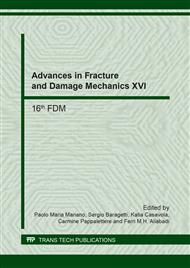p.337
p.341
p.345
p.349
p.353
p.359
p.363
p.367
p.371
Comparison of Calibration Functions for Short Edge Cracks under Selected Loads
Abstract:
Attention to the fatigue cracks in steel structures and bridges has been paid for long time. In spite to efforts to eliminate the creation and propagation of fatigue cracks throughout the designed service life, cracks are still revealed during inspections. Note, that depending on location of initial crack, the crack may propagate from the edge or from the surface. The theoretical model of fatigue crack progression is based on linear fracture mechanics. Steel specimens are subjected to various load (tension, three-and four-point bending, pure bending etc.). The calibration functions for short edge cracks are compared for various load and the discrepancies are discussed.
Info:
Periodical:
Pages:
353-356
Citation:
Online since:
September 2017
Authors:
Price:
Сopyright:
© 2017 Trans Tech Publications Ltd. All Rights Reserved
Share:
Citation:


